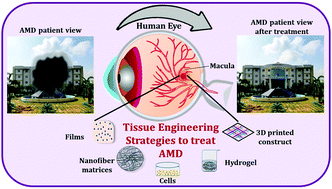Tissue engineering approaches towards the regeneration of biomimetic scaffolds for age-related macular degeneration
Abstract
Age-related macular degeneration (AMD) is the third major cause of blindness in people aged above 60 years. It causes dysfunction of the retinal pigment epithelium (RPE) and leads to an irreversible loss of central vision. The present clinical treatment options are more palliative in controlling the progression of the disease and do not functionally restore the degenerated RPE monolayer and photoreceptors. Currently, the clinical transplantation of RPE cells has shown poor engraftment potential due to the absence of an intact Bruch's membrane in AMD patients, thereby the vision is unable to be restored completely. Although tissue engineering strategies target the development of Bruch's membrane-mimetic substrates, the challenge still lies in the development of an ultrathin, biologically and mechanically equivalent membrane to restore visual acuity. Further, existing limitations such as cellular aggregation, surgical complications including retinal tissue damage, tissue rejection, disease transmission, inferior mechanical strength, and the loss of vision over time demand the search for an ideal strategy to restore the functional RPE. Hence, this review aims to provide insights into various approaches, from conventional cell therapy to 3D bioprinting, and their unmet challenges in treating AMD by outlining the pathophysiology of AMD and the host tissue response with respect to injury, treatment and preclinical animal models.



 Please wait while we load your content...
Please wait while we load your content...